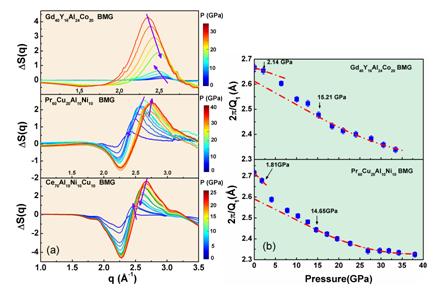| Electronic Structure Inheritance and Pressure-Induced Polyamorphism in Lanthanide-Based Metallic Glasses |
| From: PublishDate:2013-06-15 Hits: |
Metallic glasses have been extensively researched due to its special structure and properties. However, the electronic structure of the metallic glasses remains unclear. In the 1980s, the pressure-induced transition between low density amorphous and high density amorphous which was called polyamorphism phenomenon was found in water for the first time followed by SiO2 glasses, GeO2 glasses, Si and P. Researchers think that there isn’t the polyamorphism phenomenon in the metallic glasses due to the non-orientation metallic bond. The compressive behavior of Gd40Y16Al24Co20 and Pr60Cu20Al10Ni10 BMGs under high pressure by in situ angle-dispersive X-ray diffraction (ADXRD) was researched in the 4W2-High Pressure station of BSRF by professor Gong Li and her team from Yanshan University. No sharp Bragg peaks are detected from Synchrotron radiation x-ray diffraction spectra under high pressure of Gd- and Pr-based BMGs, which means the samples’ glassy nature are quite stable at ambient temperature. However, the orientation of the peak of structure factor, S(q), changes under high pressure, so there must be transition of the structure of BMGs. When analyzing the first peak of the BMGs under different pressure, the team found that there exist two different states: low density amorphous and high density amorphous. The team also investigated the Zr- and Co-based BMGs. No polyamorphism phenomenon was found in the above BMGs. Lanthanides-based BMG systems have special electronic structures, which are characterized by a gradual filling of the 4f shell. The polyamorphism phenomena are thought to be caused by the special 4f shell. The team also checked the phase change under high pressure for Mg65Cu25Tb10 BMGs with 4f electrons shell state lanthanide component, Tb which does not act as solvent element. No polyamorphism was found under high pressure. The team draws a conclusion that the polyamorphic transition in the lanthanide BMGs inherits from solvent component’s crystalline polymorphic transitions related to the 4f electronic state. The compressive behavior of pure rare-earth under high pressure is similar to that of rare-earth based metallic glasses. The 4f1 component basically is a pure localized 4f configuration. During compression, the itinerant 4f0 appear and grow with increasing pressure while the intensity of the 4f1 component decreased followed by the volume collapse, which leads to structure transition. The research provides evidence for the electronic-structural inheritance in metallic glasses, which might be important for under-standing the structure and the polyamorphism in BMGs and helpful for designing new BMGs with unique properties. Their research has been published on Phys. Rev. Lett.109. 125501 (2012).
Fig.1 (a) The difference plot of for Gd40Y16Al24Co20, Pr60Cu20Al10Ni10, and Ce70Al10Ni10Cu10 BMGs. (b) Inverse FSDP positions of Gd40Y16Al24Co20, and Pr60Cu20Al10Ni10 BMGs
Fig.2 Schematic illustration of phase transition in metallic glasses related to the 4f electronic state.
Article: G. Li,* Y.Y. Wang, P. K. Liaw, Y. C. Li, and R. P. Liu, Electronic Structure Inheritance and Pressure-Induced Polyamorphism in Lanthanide-Based Metallic Glasses,Physical Review Letters, 109, 125501, 2012. |
|
|
| Chinese
Science Highlights
Home /
Copyright © 2011 - 2012 Beijing Synchrotron Radiation Facility



